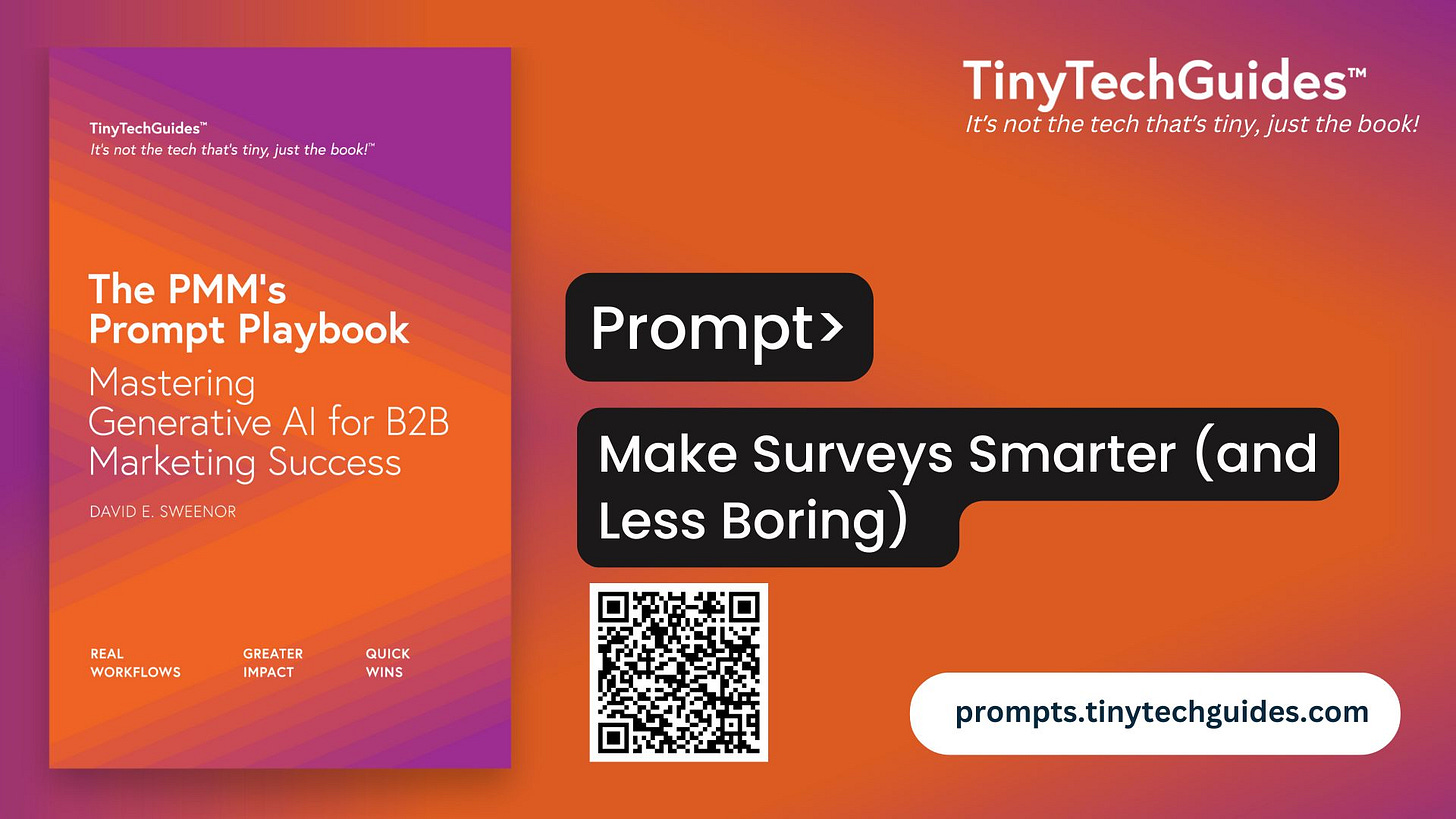Make Surveys Smarter (and Less Boring)
A prompt-driven workflow for building engaging surveys that reveal what your audience really thinks.
Workflow Name: Survey Design & Feedback Insight Generator
Created by prompts.tinytechguides.com
This prompt is part of The PMM’s Prompt Playbook which has 30 ready-to-use prompts. If you’re looking for more cut-and-paste prompts, join the Substack! Paid subscribers receive new cut-and-paste prompts every week.
Get the PMM’s Prompt Playbook and Modern B2B Marketing today!
Need help with product marketing or prompts? Let me know.
What this Workflow Does:
This workflow helps you craft a well-structured survey tailored to your specific goals—whether you’re gauging satisfaction, collecting feedback, or testing a hypothesis. It guides you through defining what matters, writing clear, unbiased questions, mixing up formats to keep it groovy, and setting up a process that delivers insights you can actually use.
Workflow Steps:
Step 0: Define inputs
Step 1: Identify key themes or areas to explore
Step 2: Draft a balanced mix of survey questions
Step 3: Apply neutrality and bias checks
Step 4: Internal test for clarity and usefulness
Step 5: Deploy and analyze results
Step 0: Define Inputs
{survey_goal} = What is the main purpose of the survey?
{target_audience} = Who will be taking this survey?
{key_areas} = What are the primary themes or topics the survey should cover?
{question_types} = Preferred mix of question types (e.g., multiple choice, rating scale, open-ended)?
{desired_insights} = What kind of insights or decisions do you want this survey to help with?
{survey_length} = Approximate number of questions or time it should take (e.g., 5 questions, 3 minutes, etc.)
Step 1: Identify Key Themes or Areas
Goal: Refine the focus areas the survey should cover.
# Role: Market research strategist
# Context: You’re helping design a survey to achieve the following goal: {survey_goal}.
The survey will be taken by: {target_audience}.
These are the high-level topics to explore: {key_areas}.
# Task: Identify 3–5 refined themes or categories the survey questions should cover.
Make sure they align with the goal and audience.
# Format: Bullet list with a 1-sentence explanation per theme.
# Tone: Professional and clear.
Step 2: Draft Survey Questions
Goal: Create an effective set of questions that cover key areas and meet time/length goals.
# Role: Survey design expert
# Context: You’ve identified the key areas as: {key_areas}.
The survey is aimed at: {target_audience}, with the goal of: {survey_goal}.
Preferred question types: {question_types}.
Survey length: {survey_length}.
# Task: Draft survey questions (up to {survey_length}) using a balanced mix of question types.
Each question should align with a key area and help meet the survey goal.
# Format: List questions by number. Include question type in parentheses after each.
# Tone: Neutral and clear, free of bias.
Step 3: Apply Neutrality and Clarity Checks
Goal: Ensure each question is unbiased and easy to understand.
# Role: Survey editor
# Context: You’re reviewing survey questions for a project targeting: {target_audience}.
The goal is: {survey_goal}, and key areas include: {key_areas}.
# Task: Review each question for bias, leading language, and unclear phrasing.
Suggest revisions to improve neutrality and clarity.
# Format: Table with columns — Original Question | Issue (if any) | Suggested Revision
# Tone: Analytical but constructive.
Step 4: Prepare Internal Testing
Goal: Create a simple plan to test the survey before launch.
# Role: Research coordinator
# Context: You’re preparing an internal test of a survey aimed at: {target_audience},
designed to achieve: {survey_goal}. The test should confirm clarity, flow, and estimated completion time ({survey_length}).
# Task: Write a checklist for internal testers and provide a simple feedback form template.
# Format: Bullet list of instructions + feedback form with open-ended fields (e.g., “What was unclear?”, “Any confusing questions?”, etc.)
# Tone: Friendly, efficient, and clear.
Step 5: Plan Deployment and Analysis
Keep reading with a 7-day free trial
Subscribe to B2B Marketing Prompts by TinyTechGuides to keep reading this post and get 7 days of free access to the full post archives.


